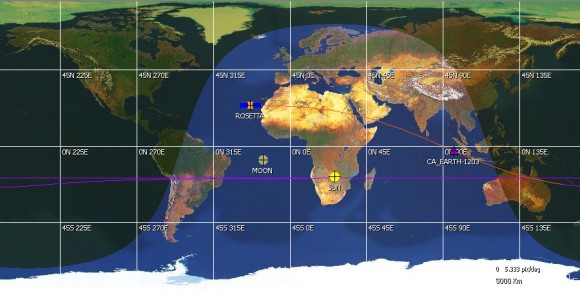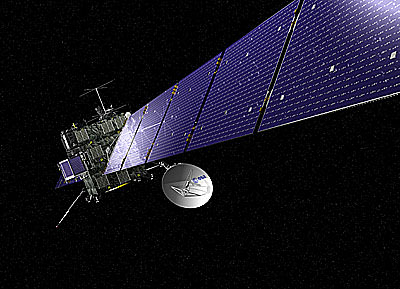The comet chasing spacecraft Rosetta will make its third and final swing by the Earth on November 13th to pick up more speed for the last part of a 10-year journey that lies ahead. Its mission is to place a lander on comet 67P/Churyumov-Gerasimenko and chase the comet for an entire year on its orbit around the Sun. The spacecraft will be visible to observers from the ground in certain locations on the Earth. This last flyby will increase the spacecraft’s speed by 3.6 km/s (2.2 miles/s) with respect to the Sun, giving Rosetta the energy it needs to boost it to the outer regions of the Solar System.
Rosetta was launched March 2nd, 2004, and will visit a host of targets on its way to comet 67P/Churyumov-Gerasimenko. Rosetta already paid a visit to asteroid 2867 Steins in September 2008. It will visit comet 21 Lutetia 10 June 2010, after which it will go into hibernation until it reaches its final destination in May 2014.
Once Rosetta arrives at 67P/Churyumov-Gerasimenko, it will deploy its Philae lander on the comet’s nucleus, and continue to orbit and study the comet for an entire year during its closest orbit of the Sun. This is the first mission ever to orbit and land on a comet, and promises to return a wealth of data on cometary interaction with the Sun. Comets also contain mostly undisturbed materials from the formation of the Solar System in their nuclei, so studying their composition gives scientists an look into how our Solar System developed.
During the flyby of Earth in November of 2007, Rosetta took the breathtaking image of the Earth pictured here. This next flyby will give observers on the ground a chance to take a look back at Rosetta. The closest approach will occur on November 13th at 8:45 Central European Time (07:45 UT).
Unfortunately, the spacecraft will only be visible from parts of Europe, South America and Africa, as can be seen in the image below. If you are in these regions during the approach, and have favorable conditions, there is a wealth of observing information on the Rosetta blog, specifically on the posts Tips for Sky Junkies I and Tips for Sky Junkies II. They will also be closely following the flyby on the blog, so you can check there for updates on the eve of the event if you are outside the observable range of the spacecraft.
As always, you can check back with us on Universe Today for more coverage of Rosetta’s journey!
Source: ESA


WOW… ten years is a loooong time! Am sure it will be worth the wait, but this mission seems to stand out as a ‘poster child’ for something like the Russian nuclear rocket engine, chatted up recently in this site…
Should ever the day come when we spot an incoming comet or asteroid that will intersect Earth’s orbit, then we’d definitely want to get out there as fast as possible to take a look to determine if there was anything we could do, like alter its orbit somehow (early is good!) or even vaporize the intruder with nukes?